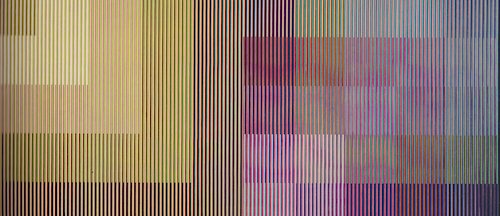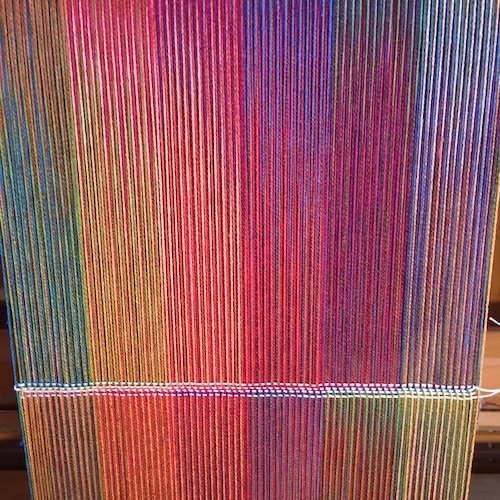Color in Space and Time
In June of 2011 I taught at the Contemporary Weavers of Texas conference, and afterwards went back to Houston for a couple days with my friend and weaver, Laura Viada. She told me that she had recently seen an amazing exhibit at the Houston Museum of Fine Arts and she thought it was something that I would want to see as well. Was she ever right!
The exhibit was a retrospective show of fifty-some years of work by the Venezuelan artist Carlos Cruz-Diez, titled Color in Space and Time. I had never heard of him before and immediately wondered where he had been all my life. The entire large upper floor of the museum was devoted to his work, and we ended up spending the better part of a day there.
Much of the work was in the form of large paintings that filled entire walls, though there were pieces in a large variety of media. There was also an entire environment that you entered and found both yourself and the space you were in bathed in colored light that shifted as you moved through the environment. None of the work was in fiber, yet I saw weavings everywhere I looked.
Carlos Cruz-Diez, Physichromie 684
I was particularly entranced with the large wall paintings that were composed of multicolored vertical linear elements. Standing back from the paintings I could see colors such as pinks and purples, and yet when I moved closer I could see that those colors didn’t exist in the paintings, but were a sensation created by the eyes and the brain. And as I walked from one end of a painting to the other the colors changed before my very eyes. It was utter magic, and I would have to say that it was one of the most incredible exhibits I have ever seen.
I would have loved to have returned again and again, but instead bought the book that documented the show and took it home with me. Over the next months and years I spent many hours looking at the images in the book, trying to imagine how I might be able to achieve a similar sense of shifting colors in weaving.
Forward to the summer of 2016. I had been exploring rotations of four colors in the warp and weft in doubleweave for some time, and was planning to weave some more examples of that for an issue of Heddlecraft that I was writing for Robyn Spady. I pulled a dozen or more cones of yarn off my shelves and started moving the cones around, eliminating the colors that didn’t fit in. Eventually I got the number of colors down to six, but every time I removed one of them from the lineup I felt that something was missing. Finally I decided to work with all six of the colors in a systematic rotation.
As soon as I wound the warp and got it onto my loom I had a feeling that something wonderful was going to happen. I realized then that the six colors I was working with - blue, green, yellow, orange, red, purple - were the three primary and three secondary colors of the classic subtractive color wheel, and that was why I felt that something was missing if I removed any one of the colors.
As I started weaving and lifting different sets of threads for the two layers of doubleweave I let out a gasp. I was seeing the colors appear to change before my eyes as they passed through each other, much like the way the colors in Cruz-Diez paintings appeared to shift as you walked past them.
Detail of Cruz-Diez's Physichromie 818
Double Rainbow warp on loom
This visual effect is ephemeral because it happens as you switch from lifting one set of shafts to another. I found myself weaving with my phone on the bench next to me so I could take photos of these effects in the moment that they were happening. Additionally, as the reflection from the reed passed over the warp amazing moire effects were created.
Color has been a fundamental aspect of my work in doubleweave since I started working in the technique nearly 40 years ago. Students had been asking me for years when I was going to offer a course on color, and I knew that I would have one some day, but didn’t know exactly what my particular approach in a workshop would be. As soon as I started weaving the color rotations on this warp I knew that this was my workshop on color, and Double Rainbow was born.
By cycling the six colors in a systematic rotation in the warp, cycling through the six colors in a rotation in the weft, and cycling through the six different warp combinations possible in two layers on four shafts, a total of 90 distinct color combinations are created. I have experimented with this approach using primary colors, pastel colors, earth tones, neutrals, and it seems that beautiful combinations are created no matter which colors you work with.
Every once in a while in the many years that I’ve been weaving something very special happens that I feel is bigger than what I put into it - as though a greater force is moving through me. This was certainly one of those times. This felt like perhaps the most fun that I had ever had sitting at a loom, and perhaps what I would want to spend the rest of my weaving life doing.
I wanted Mr. Cruz-Diez to know how much he had inspired me and how much impact he had had on my work. After doing an internet search I was able to find the address of his studio in Paris and wrote him a letter, not expecting a reply. A number of months later I received an email from an assistant in his studio saying that she had passed my letter on to Mr. Cruz-Diez. She invited me to visit his studio in Paris if I should ever find myself there. That will never happen now, but I hope that Mr. Cruz-Diez was able to feel some sense of joy, knowing how much his work had meant to me
In October of 2018 I was teaching my Double Rainbow workshop in Houston, and it happened that an installation of Cruz-Diez’s was open at the underground cistern under Sabine Street. Multicolored lights were projected onto columns and white cubes that appeared to be floating and rotating as the lights shifted. It was an otherworldly experience to walk through this space and feel yourself floating and rotating along with the columns and cubes. You can read about the installation and see images from it here: https://www.houstonchronicle.com/entertainment/theater/article/Carlos-Cruz-Diez-colors-up-the-Cistern-with-new-12902077.php#photo-15530418.
Carlos Cruz-Diez passed away on July 27, 2019 at the age of 95. His work lives on all around the world, and certainly in my mind and imagination.








